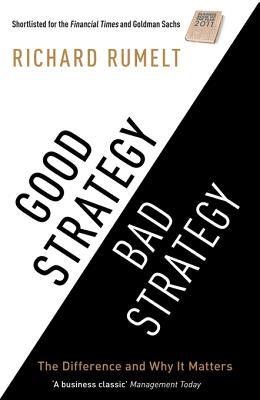More on this book
Community
Kindle Notes & Highlights
Read between
December 28, 2024 - January 28, 2025
The core of strategy work is always the same: discovering the critical factors in a situation and designing a way of coordinating and focusing actions to deal with those factors.
A word that can mean anything has lost its bite.
good strategy includes a set of coherent actions. They are not “implementation” details; they are the punch in the strategy. A strategy that fails to define a variety of plausible and feasible immediate actions is missing a critical component.
Of course, a leader can set goals and delegate to others the job of figuring out what to do. But that is not strategy. If that is how the organization runs, let’s skip the spin and be honest—call it goal setting.
The kernel of a strategy contains three elements: a diagnosis, a guiding policy, and coherent action.
“I am going to wait for the next big thing.”
Good strategy requires leaders who are willing and able to say no to a wide variety of actions and interests. Strategy is at least as much about what an organization does not do as it is about what it does.
Bad strategy fails to recognize or define the challenge.
Mistaking goals for strategy. Many bad strategies are just statements of desire rather than plans for overcoming obstacles.
describing a destination is no substitute for developing a comprehensive roadmap for how the country will achieve its stated goals.”
The basic problem is confusion between strategy and strategic goals.”
Bad strategy is long on goals and short on policy or action. It assumes that goals are all you need. It puts forward strategic objectives that are incoherent and, sometimes, totally impracticable. It uses high-sounding words and phrases to hide these failings.
If you fail to identify and analyze the obstacles, you don’t have a strategy. Instead, you have either a stretch goal, a budget, or a list of things you wish would happen.
For example, it retains program managers for only four to six years to limit empire building and to bring in fresh talent.
To obtain higher performance, leaders must identify the critical obstacles to forward progress and then develop a coherent approach to overcoming them.
The need for true strategy work is episodic, not necessarily annual.
It is strategy which transforms these vague overall goals into a coherent set of actionable objectives—
the objectives a good strategy sets should
stand a good chance of being accomplished, given existing resources and competence.
When a leader characterizes the challenge as underperformance, it sets the stage for bad strategy. Underperformance is a result. The true challenges are the reasons for the underperformance.
Leadership and strategy may be joined in the same person, but they are not the same thing.
Good strategy is coherent action backed up by an argument, an effective mixture of thought and action with a basic underlying structure I call the kernel.
The kernel of a strategy contains three elements:
1. A diagnosis that defines or explains the nature of the challenge.
2. A guiding policy for dealing with the challenge.
3. A set of coherent actions that are designed to carry out the guiding policy.
In many large organizations, the challenge is often diagnosed as internal. That is, the organization’s competitive problems may be much lighter than the obstacles imposed by its own outdated routines, bureaucracy, pools of entrenched interests, lack of cooperation across units, and plain-old bad management.
A great deal of strategy work is trying to figure out what is going on.
most deep strategic changes are brought about by a change in diagnosis—a change in the definition of the company’s situation.
Good strategy is not just “what” you are trying to do. It is also “why” and “how” you are doing it.
Strategy is about action, about doing something.
The impediment was the hope that the pain of those actions could, somehow, be avoided.
strategy is primarily about deciding what is truly important and focusing resources and action on that objective.
a good strategy works by harnessing power and applying it where it will have the greatest effect.
An important duty of any leader is to absorb a large part of that complexity and ambiguity, passing on to the organization a simpler problem—one that is solvable.
Many leaders fail badly at this responsibility, announcing ambitious goals without resolving a good chunk of ambiguity about the specific obstacles to be overcome.
What one single feasible objective, when accomplished, would make the biggest difference?
To concentrate on an objective—to make it a priority—necessarily assumes that many other important things will be taken care of.
One hundred mediocre singers are not the equal of one top-notch singer.
The problem arises because of quality matching.1 That is, if you are in charge of one link of the chain, there is no point in investing resources in making your link better if other link managers are not.
it is human nature that the easy life breeds laxity.
It is also human nature to associate current profit with recent actions, even though it should be evident that current plenty is the harvest of planting seasons long past.
Success leads to laxity and bloat, and these lead to decline.
Just as in a large university, the breakthroughs of a tiny number of very talented individuals had been used to justify a contemplative life for thousands of others.
A new strategy is, in the language of science, a hypothesis, and its implementation is an experiment.
The ultimate worth of a strategy is determined by its success, not its acceptability to a council of philosophers or a board of editors.
Being strategic is being less myopic—less shortsighted—than others.
The inside view describes the fact that people tend to see themselves, their group, their project, their company, or their nation as special and different.


